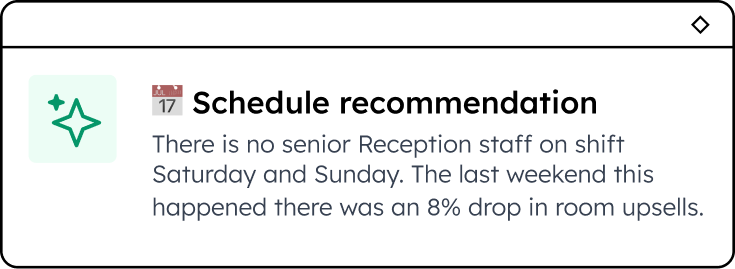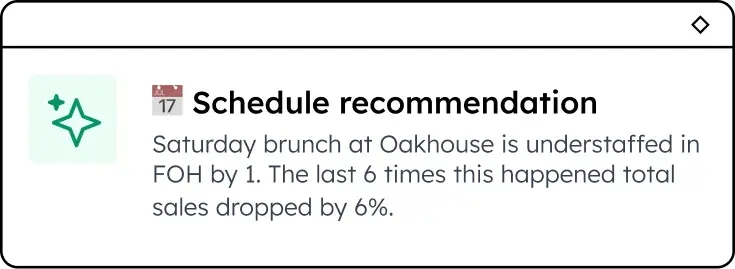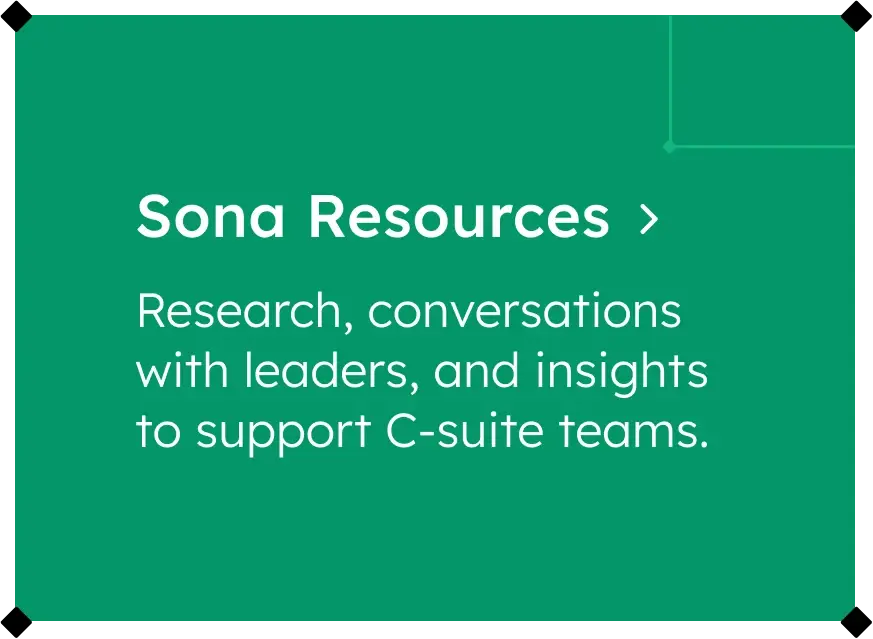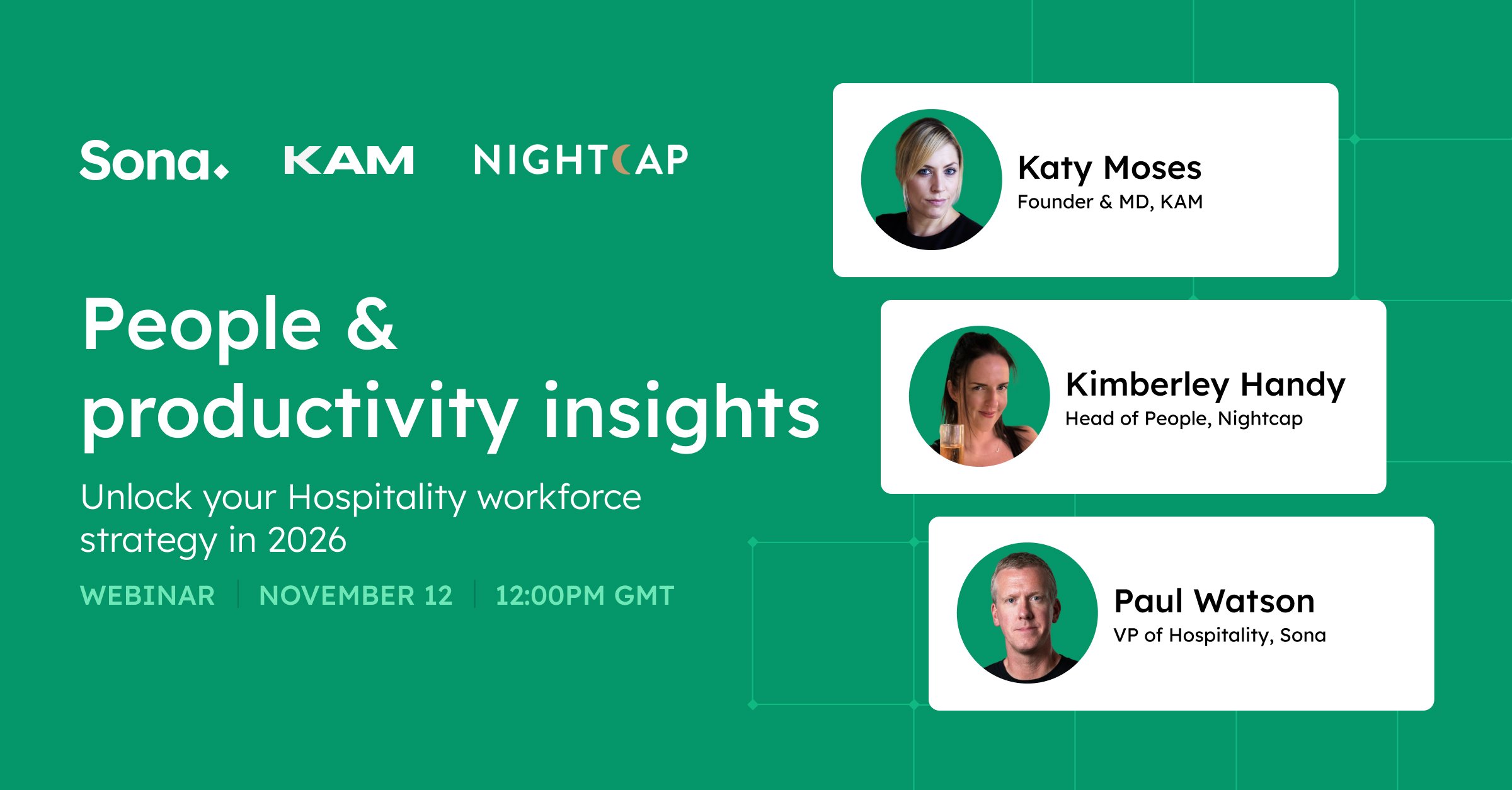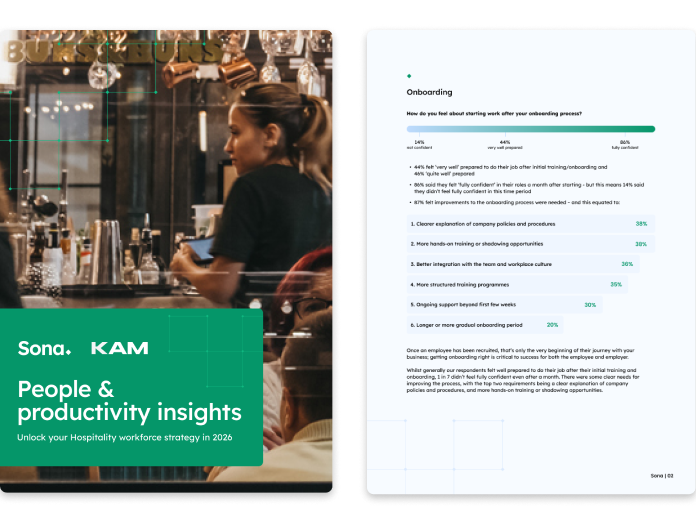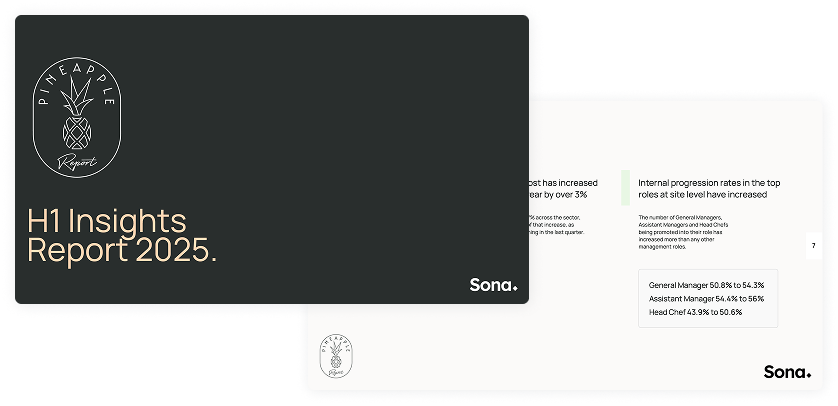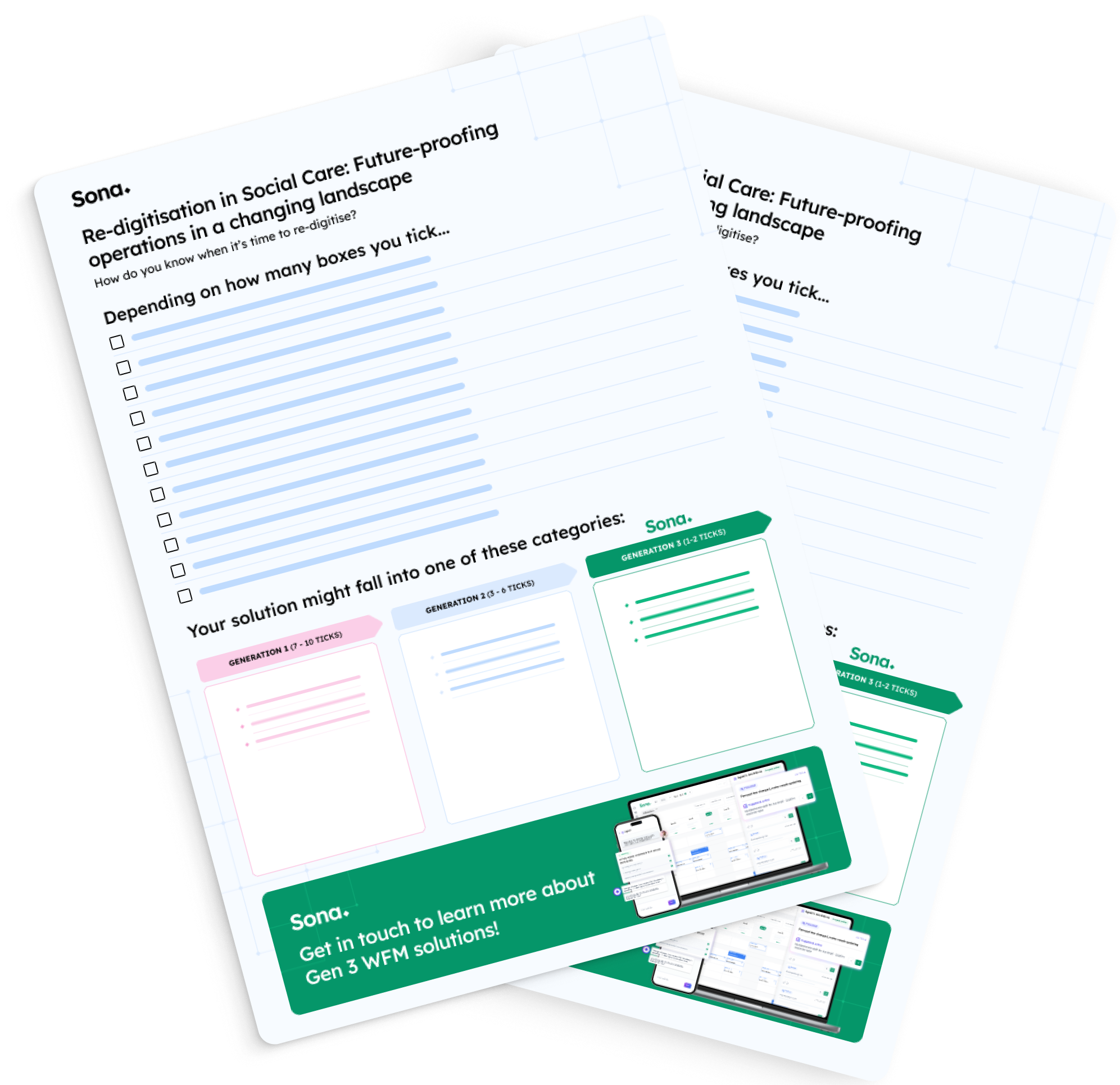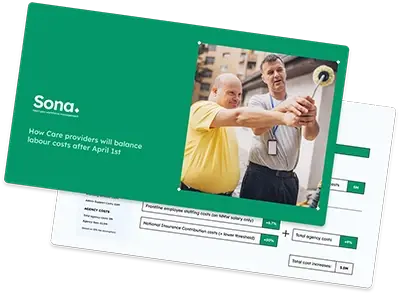Insight, Digital Transformation, Workforce Management
Deskless, not voiceless: The rise (and benefits) of ongoing frontline employee feedback
Frontline staff, representing a large proportion of the global workforce, have historically faced a communication divide. Whether they're healthcare professionals, hospitality staff, or retail assistants, their ability to provide direct feedback to management has often been limited. But today, innovative platforms like Sona are stepping up to bridge this gap, ensuring everyone can be heard and recognised.
6 minute read

The historical communication challenges
Traditionally, feedback mechanisms for frontline workers have been a challenge to implement. A large number of employees with different responsibilities and skills, and based in various locations can mean that organisations struggle to gather feedback effectively.
Multiple-choice surveys have usually been the only viable solution, but they don’t always reveal the underlying issues specific to each employee. At the same time, face-to-face interviews are not feasible for many organisations, and the data they provide is hard to quantify. Such gaps in communication contribute to serious challenges, like high turnover rates and diminishing morale.
The key to a healthier, more engaged workforce lies in establishing a culture of ongoing feedback.
Regular, quantifiable communication allows for managers to identify issues in real-time and be proactive in solving them. This fosters a more responsive and dynamic work environment that employees can thrive in. The shift from occasional to continuous feedback can significantly enhance satisfaction and operational efficiency.
The digital transformation of feedback
Modern solutions, like Sona, have transformed the feedback process.
Managers can now:
- Collect immediate feedback 🙋♂️
Post-shift feedback requests ensure real-time data collection, making sure no concern lingers unanswered for too long. - Promote honesty 😇
By ensuring feedback confidentiality, organisations can encourage candid and actionable insights. - Capture diverse data 📋
From a simple mood check-in to intricate feedback, platforms are now equipped to gain an in-depth understanding of every team member's experience.
Benefits of adopting a feedback platform
Deploying a new solution that might influence the lives of hundreds (or thousands!) of staff members can be intimidating to them - and rightfully so. Communicating the benefits well and ensuring that everyone feels supported throughout the process is key to a successful implementation.
These are some of the benefits organisations can communicate to employee in order to obtain their buy-in:
- Boosted morale and well-being 💚
Staff will likely observe a more positive work environment where their contributions are recognised and valued, leading to higher morale and job satisfaction. - Improved operational efficiency and communication ⚙️
Actionable insights from daily feedback can help you implement immediate operational enhancements. At the same time, employees will be empowered to voice concerns and provide feedback easily, without feeling overlooked. - Rising retention rates 📈
With early warning notifications, managers can identify people at risk of churn, and intervene before it's too late. - Empowered staff 💪
Employees will see that their feedback is not only heard but acted upon. This could be in the form of policy changes, improved working conditions, or operational adjustments, leading to a sense of ownership over their work environment.
Additionally, when a feedback platform communicates well or is part of a larger system that includes HR and/or rostering, it can provide additional depth to the information collected. For example, it can help answers questions like:
- When is turnover most likely to occur?
- How is new joiner morale?
- Is there a correlation between tenure and overall satisfaction?
- Does seniority or location impact employee happiness?
These learnings can then inform your retention strategy and ensure employees stay with you long-term, saving you recruitment costs and helping you offer a better service overall.
Choosing the right feedback platform
Selecting the appropriate feedback platform for an organisation isn't a decision anyone makes lightly. Careful consideration and a thorough understanding of both the needs of your workforce and the capabilities of the platform are necessary. When embarking on this decision-making journey, it is vital to weigh the pros and cons.
This process involves more than just comparing features; it is about aligning the platform's offerings with your organisation's specific goals and the unique challenges faced by frontline staff.
As you sit down to chart out your options, consider if the solution in question:
- Caters specifically to frontline workers 👩⚕️
Frontline teams face specific challenges that generic solutions don't always cover well, therefore software designed with this sector in mind will prove more useful. - Offers scalability and customisation 🔧
Customisable well-being dashboards allow managers to keep a real-time pulse on team morale across different locations, especially when organisations aim for rapid growth.
In addition to the basic features above, the ideal platform will also have:
- Well-being check-ins 🩺
These allow managers to monitor team morale and take preemptive actions, ensuring preventable churn is minimised. - Instant recognition 🎖
Employees receive immediate notifications when praised, embedding a culture of appreciation. - Comprehensive reporting 🖥
This feature should offer detailed well-being reports, helping managers to spot trends and take proactive actions.
Using feedback platforms to improve staff retention
Early warning notifications can be a huge help for managers looking to identify members of the team who might be struggling, and address their concerns.
There are a few key steps when implementing a feedback platform with retention in mind:
- Define key indicators 📊
Identify the specific metrics or signs that could indicate potential problems. These might include sudden drops in employee engagement scores, increased rates of absenteeism, or negative trends in feedback topics. - Set thresholds 📉
Establish thresholds or trigger points for each indicator. When these thresholds are crossed, it should trigger an early warning notification. - Automate alerts 🚨
Use the feedback platform to set up automated alerts for when key indicators reach critical levels. Ensure these alerts are directed to relevant managers or HR personnel. - Analyse data in real time 🕰
Implement tools that allow for real-time analysis of feedback data. This ensures that any concerning trends are identified as soon as possible. - Respond quickly 🚀
Develop protocols for how to respond when an early warning is triggered. This might include meetings with concerned teams, one-on-one check-ins with employees, or a review of recent changes that might have impacted morale. - Feedback to employees 🗣
Communicate with employees when their feedback has initiated an early warning. This can build trust and encourage continued honest feedback. - Regularly review key indicators 📅
Periodically review and adjust the key indicators and thresholds to ensure they remain relevant and effective. - Train management 🎓
Train managers and team leaders on how to interpret and act on early warning notifications. This helps to foster a proactive approach to employee well-being and satisfaction. - Analyse your interventions 👀
After responding to an early warning, analyse the effectiveness of the intervention to refine future responses.
By implementing these steps, your organisation can create a robust early warning system that prioritises employee well-being. By using their feedback to inform policies, you can create healthy and supportive work environment that boosts retention and productivity.
Pitfalls to avoid when implementing a feedback system
A feedback system can be a transformative step towards improving employee engagement and efficiency. However, these are some pitfalls organisations need to be aware of:
- Overcomplication and inaccessibility 🤯
A system that is too complex or inaccessible can lead to low participation rates. Be sure to choose a user-friendly platform and provide multiple accessible ways for employees to give feedback. - Failure to act on feedback ❌
Collecting feedback without any follow-up action can lead to frustration and decreased trust in the system. Developing a clear process for reviewing and acting on feedback, then regularly updating employees on the changes made can address this. - A one-size-fits-all approach 👕
Different groups of employees may have unique feedback needs and preferences. Tailor the feedback mechanism to suit various groups within the workforce, considering factors like job role, location, and working conditions. - Lack of training and communication 💬
Employees and managers might not use the system effectively if they are not adequately trained. Provide comprehensive training for all users, and maintain clear, ongoing communication about the system’s goals and benefits. - Frequent changes or inconsistencies 🤷♂️
Constantly changing the feedback system can lead to confusion and disengagement. Aim for consistency in the feedback process, and make changes only when necessary, while being transparent with employees regarding the overall process.
By being mindful of these pitfalls, organisations can create an effective and trusted feedback system that genuinely supports and benefits their frontline teams.
The era of frontline employees feeling disconnected can be consigned to history. With platforms like Sona, not only is the feedback gap being bridged, but an environment of well-being, appreciation, and open communication is can be fostered. For businesses seeking to empower their employees, adopting such practices isn't just a choice - it's a necessity.
Enjoyed this article? Let's stay in touch 👋
If you liked this article, why not subscribe to our newsletter to get the latest news and views delivered straight to your inbox?

